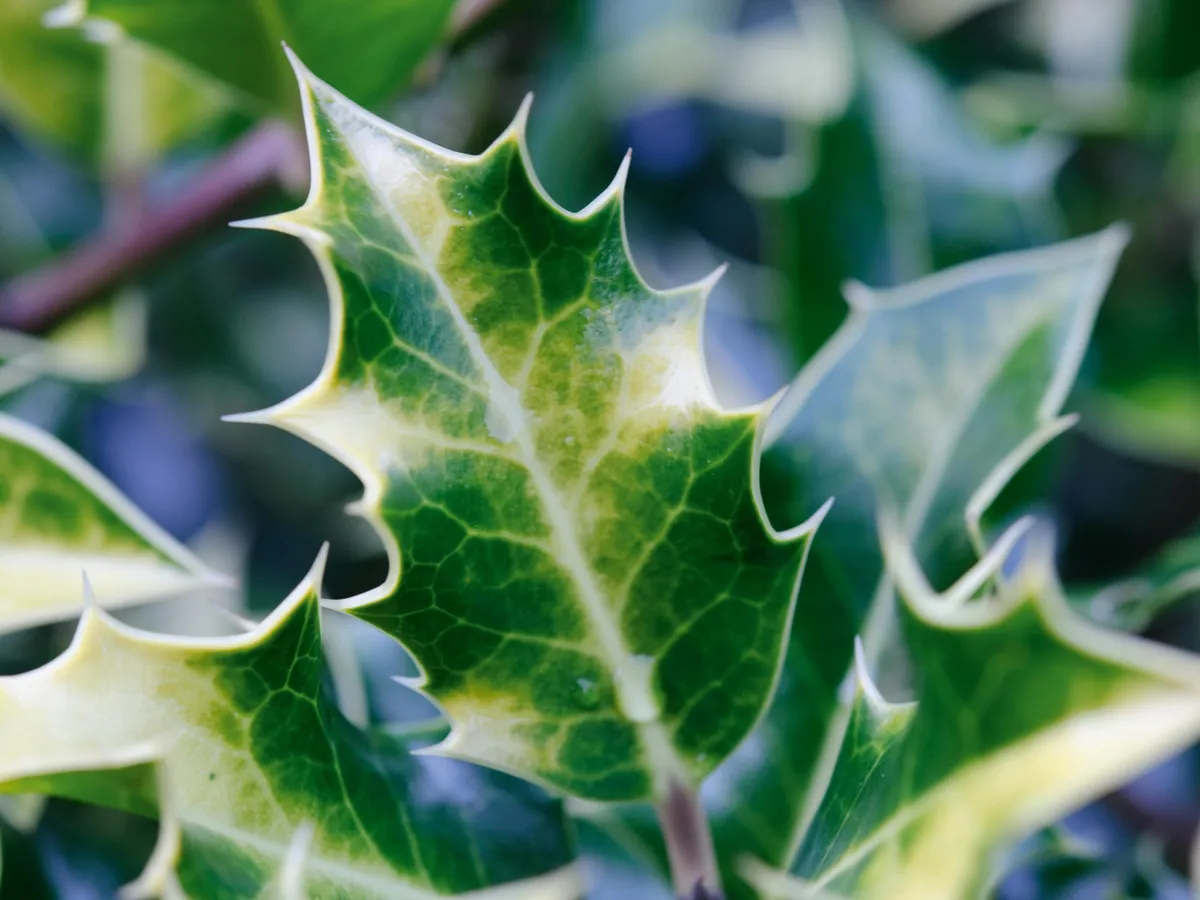In David Domoney's new book, Plants with Superpowers: 75 Remarkable Plants for your Garden and Home, David shares an incredible array of plants with extraordinary capabilities. After considerable research into myths, legends, and scientific papers, David illustrates that the natural world has truly gifted plants with superpowers.
The 75 featured plants in the book each have unique abilities that are wondrous to adults and children alike - and they can all be found growing in our gardens, homes and parks.
SQUIRREL_13190393
Here, David shares 10 plants with a dazzling array of powers, from producing electricity to surviving an atomic bomb, and from clearing radiation to being able to count.
You may also like:
The deceptive tricks that orchids use to attract pollinators
Nine common garden plants that can help ease stress and burnout
12 myths every gardener should know about slugs
10 plants with superpowers
Horse chestnut (Aesculus hippocastanum)

Superpower: cleansing
Collected and coveted by generations of children, there is something magical about the fruit of the horse chestnut tree. Hidden inside spiny-cased pods, waiting to be liberated by nimble fingers, lie beautiful, mahogany-brown conkers. The contrast between the prickly, dull-green armour and the shiny treasure within makes the conker even more special. Yet there is more magic within: the conker fruit provides a type of natural soap. It’s believed the Vikings used them to stay clean-ish. The active ingredient is saponin, which works as a handy organic detergent for lifting dirt and grease. You’ll sometimes find it added to shampoos and shower gels. On autumn days when horse chestnuts drop their conkers onto wet roads and they get mashed up by passing cars, you’ll sometimes see bubbles forming amid the debris as if someone has spilled detergent.
Dictamnus (Dictamnus albus)

Superpower: Spontaneous combustion
The gas plant isn’t known colloquially as the burning bush for nothing. On hot windless days, this ornamental flowering plant will burst into flames in a flash if it comes into contact with a source of ignition – and sometimes without even needing one. The flames are fed by naturally occurring, volatile oils from its flowers which, once ignited, swiftly burn themselves out, leaving the plant largely unharmed. It’s a fascinating piece of garden chemistry. The plant’s oils decompose into a naturally flammable compound called chavicol, a type of phenylpropene, a flammable liquid or vapour. In the absence of a breeze, this can build up around the plant, creating the conditions for ignition when a flashpoint is triggered either by high temperatures or, more commonly, a spark. It’s believed gas plant primarily produces these chemicals as an unpleasant scent to deter insects, rather than for reasons of combustion, but both would have a deterrent effect if you were a greenfly.
Dumb cane (Dieffenbachia)

Superpower: Takes your voice
The dumb cane gets its name because it can quite literally stop you talking if ingested – not that it’s a good idea to try. Chewing and eating this plant causes temporary paralysis of the vocal cords, tongue, mouth and throat. And if you were to rub the sap into your eyes, and you absolutely must not, it can even lead to temporary blindness and swelling of the eyelids. This is because dumb cane leaves and stems contain proteolytic enzymes and needle-like calcium oxalate crystals as a defence mechanism – effectively dissuading animals from eating them. But beware, given its toxic properties, dumb cane should not be trimmed without gloves, nor is it advisable to grow it where there are young children or pets. Make sure to wash your hands after handling.
Venus flytrap (Dionaea muscipula)
Superpower: Counting
This plant’s superpowers are astonishing – it can count and it also employs a simple form of memory. These give the Venus flytrap a crude understanding of the concept of time – something unique in the plant world. Evolving from simpler carnivorous plants, which lived on Earth 65 million years ago, this horticultural wonder has adapted into an efficient predator. It not only traps flies for food, but has also devised a system to identify whether what falls into its trap is a fly or a small leaf, by evaluating movement. Inside the flytrap’s leaves are numerous sensory hairs. If one of them is touched, the plant is alerted and this starts a calcium countdown inside. But unless another hair is touched within around 30 seconds, the plant decides it was a false alarm and resets itself. However, if another hair is touched within that 30-second window, the plant releases another burst of calcium, the trap closes on the fly, and its digestive enzymes get to work on its prey.
Snowdrop (Galanthus nivalis)

Superpower: Anti-freeze
This tough little plant flowers at the very start of the year during the cold, dark winter months – bringing us joy at the sight of its beautiful, nodding, pearl-white flowers and a foretaste of the spring to come. Snowdrops can do this because of their superpower. After all, hard winter soils and brutal frosts are not ideal conditions for flowering bulbs. But the snowdrop is no ordinary bulb. First off, its leaf tips are sharpened to help it break through the cold soil. In France, they call snowdrops perce-neige (snow piercer). While other plants freeze, burst and die in sub-zero temperatures, the snowdrop thrives, as it contains proteins that perform an anti-freeze function in its cells. This superpower inhibits ice crystals from forming, protecting snowdrops from frost. It doesn’t end there either. To spread their seeds, snowdrops enlist the largest army known to nature – ants. Each seed has a small, oil- and protein- rich appendage called an elastiome. These attract ants, which collect the seeds and carry them to their underground nests to feed the elastiome to their larvae. The seeds themselves remain untouched, effectively planted by the ants.
Sunflower (Helianthus annuus)

Superpower: Clears radiation
As well as being one of the most iconic and joyous flowering plants, sunflowers can also perform an invaluable function – acting as hyperaccumulators. This means they are able to absorb high concentrations of toxic materials including zinc, copper, lead and radioactive waste from soil and water. The contaminants are stored in the leaves and stems of the sunflower, which can later be disposed of safely. Fields of sunflowers were planted in the wake of the Chernobyl and Fukushima nuclear disasters, in Ukraine and Japan respectively, to help reduce toxin levels. Once fully grown, sunflowers were harvested and destroyed through a process called pyrolysis, which effectively burns off the plant’s organic carbons, leaving the waste metals to be stored safely without re-releasing them into the atmosphere. This process can be repeated over a period of decades until the soil improves. The technique of using living plants to clean air, soil and water, while still in its infancy, is known as phytoremediation. The term is an amalgam of the Greek phyto (plant) and Latin remedium (restoring balance). Its effectiveness depends on the concentrating effect from hyperaccumulators to bioaccumulate chemicals in their foliage.
Holly (Ilex aquifolium)

Superpower: Shapeshifting
There is something magical about holly’s ability to change its appearance, specifically the shape of its leaves. Common holly (Ilex aquifolium) happily grows lush, emerald-green leaves with smooth edges. However, if the shrub starts getting eaten, holly will fight back. Over time, its leaves regrow with prickly edges to deter common herbivores such as deer and goats. The holly can even identify at what height its foliage is being eaten, thus saving energy by leaving the higher-up, unreachable leaves smooth, while making its lower, at-risk foliage grow back spikier. This ability to carry different kinds of foliage on one plant is known as heterophylla (variable leaves). There are many cultivated varieties of holly that have been propagated with only spiky leaves, to add foliage texture to garden planning designs: for example, hedgehog holly (Ilex aquifolium ‘Ferox’) has spikes around the edges and on the leaf surfaces.
Sensitive plant (Mimosa pudica)
Superpower: Moves when touched
Often grown solely for its curiosity value, the leaves of the sensitive plant rapidly fold inward when touched or shaken, returning to their original position a few minutes later. This remarkable reaction, which you can see happening, is believed to be a defence mechanism against herbivores, changing the plant’s appearance from a healthy look to crushed and wilted within seconds. Sensitive plant achieves this incredible reaction by the movement of potassium and chlorine ions from inside to outside the plant cells. This triggers a movement of moisture, which keeps the cells full and firm, collapsing them at certain points and flopping the plant. The process also closes the leaves in high winds, helping the plant to reduce moisture loss from exposed foliage. Like a number of other species, sensitive plant also closes its leaves during darkness and reopens in the morning light, being controlled by nyctinastic circadian rhythms.
Potato (Solanum tuberosa)

Superpower: Electricity
The humble potato is nature’s battery, a store of electrochemical energy waiting to be unleashed. Researchers have claimed the low-voltage energy produced from just one good-sized potato could charge a mobile phone or light-emitting diode (LED) lamp for up to forty days. It takes only a simple experiment, beloved of chemistry teachers globally, using a zinc nail and a piece of copper wire to power a bulb, buzzer or simple machine. Simply put, the starchy acid inside the potato undergoes a chemical reaction with the zinc and copper and, as the electrons flow from one material to another, energy is released. Genetic studies show that the potato has a single origin, in the area of present-day southern Peru and extreme north-western Bolivia, where it was domesticated up to 10,000 years ago. As a plant, you might be surprised to learn it’s from the same family as deadly nightshade (Atropa bella-donna) – and, indeed, potatoes with green spots should not be eaten as they contain small amounts of toxicity, as do potato shoots.
Gingko (Gingko biloba)

Superpower: Survival
The ginkgo is the last remaining relative of the earliest trees – dating back to the Permian Period and the order of Ginkgoales of more than 250 million years ago. There are ginkgo fossils from the Jurassic Period and the Mesozoic Period – meaning you can view a leaf fossilized some 175 million years ago and then touch a living version from a tree in your garden. As a result, the ginkgo tree (also known as the maidenhair tree for the resemblance of its leaves to maidenhair fern) is considered a living fossil – an ancient plant from an era long forgotten. That would be a superpower on its own but the ginkgo has another: it can survive an atomic bomb. In August 1945 in Hiroshima, Japan, ginkgo trees had been in full leaf when the blast from an atomic bomb scorched the earth, burning away their leaves, charring their few remaining branches and scouring their trunks of bark while completely irradiating them. Yet, within a year, ginkgo trees a little more than 1.6km (1 mile) from the epicentre of the blast started to sprout shoots of green despite the radiation – becoming a symbol of hope. Today their ability to survive man’s destructive devices means they have become common sights in many city centres, thriving despite traffic pollution.
SQUIRREL_13190393
Plants with Superpowers: 75 Remarkable Plants for your Garden and Home is out on 3 April